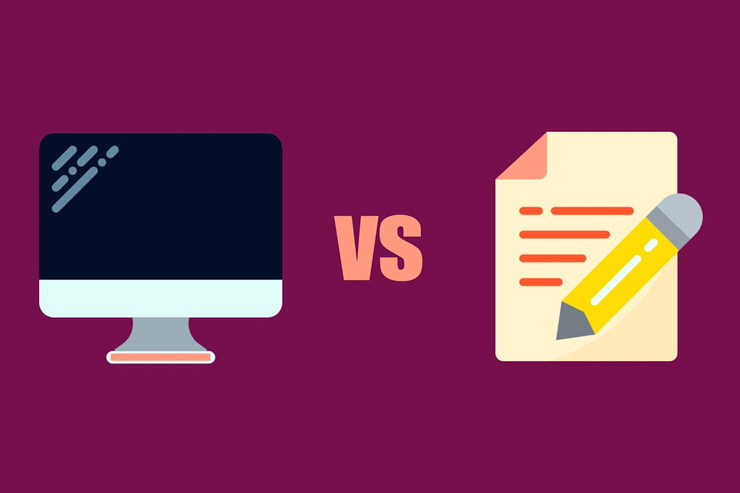Computer-Based Test vs Paper Based: Which is Better?

The choice between the computer-based IELTS (International English Language Testing System) test and the paper-based IELTS test depends on your personal preferences, comfort with technology, and the specific requirements of the institution or organization you are applying to. Both formats have their own advantages and considerations.
Pros and Cons of Choosing the Computer-Based IELTS Exam
Choosing the computer-based IELTS (International English Language Testing System) exam has its own set of pros and cons. Here are some advantages and disadvantages to consider:
Advantages:
Enhanced Test Experience: Taking the exam on a computer can provide a more interactive and user-friendly experience compared to the paper-based version. The interface allows for easy navigation between sections and questions, making it convenient for test takers.
Quick Results: With the computer-based IELTS, you can receive your test results faster. Typically, results are available within 3-5 days, whereas it may take around 13 days to receive scores for the paper-based test. This quick turnaround time can be beneficial for those who have time constraints or need immediate results.
Typing Skills Advantage: If you are more comfortable typing than writing by hand, the computer-based format allows you to type your responses. This can be advantageous for individuals who have better typing speed and accuracy, as it enables them to express their thoughts more efficiently.
Highlighting and Note-Taking: In the computer-based IELTS, you have the ability to highlight text and make notes on the screen. This feature can be useful for tasks like the reading section, where you can easily mark important information or keywords.
Test Availability: The computer-based IELTS is often more readily available than the paper-based version. It is offered multiple times a week, providing flexibility in scheduling your exam according to your convenience.
Considerations:
Familiarity with Computer-Based Testing: If you are not comfortable or familiar with computer-based testing, the transition from traditional paper-based exams might pose a challenge. It’s essential to practice using the computer interface to ensure you are comfortable and can focus on the content of the exam.
Limited Writing Space: In the paper-based IELTS, you have ample space to write your responses, whereas the computer-based format may have limited space on the screen for typing your answers. This can be a constraint, especially for individuals who prefer to brainstorm and plan their writing before composing their final response.
Potential Technical Issues: While rare, technical glitches or computer malfunctions may occur during the computer-based exam. These issues can disrupt your flow and cause stress or anxiety during the test. However, test centers usually have technical support to address such problems promptly.
Handwriting Analysis Not Applicable: Some institutions or organizations may require handwriting analysis as part of the test evaluation process. In such cases, the computer-based IELTS may not meet their specific requirements.
Noise and Distractions: In a computer-based exam, you may encounter distractions due to noise from other test takers or technical equipment. This can potentially affect your concentration and overall test performance.
Pros and Cons of Choosing the Paper-Based IELTS Exam
Choosing the paper-based IELTS (International English Language Testing System) exam has its own set of pros and cons. Here are some advantages and disadvantages to consider:
Advantages:
Familiarity and Traditional Format: The paper-based format follows a traditional exam style, which many test takers may find more comfortable and familiar. If you have prior experience with pen-and-paper exams, it can provide a sense of reassurance and confidence.
Writing Space: The paper-based format typically provides ample space for writing your responses. This can be beneficial if you prefer to brainstorm, plan, and structure your writing before composing your final answer. The physical space on the paper allows for flexibility in organizing your thoughts.
Handwriting Analysis: Some institutions or organizations may require handwriting analysis as part of the evaluation process. In such cases, the paper-based IELTS is more suitable as it allows assessors to analyze your handwriting style, which can provide additional insights into your language proficiency.
Considerations:
Longer Results Waiting Time: The paper-based IELTS exam generally takes longer for results to be processed and released. It can take around 13 days to receive your test scores, which may not be suitable for individuals with time constraints or those who require immediate results.
Limited Flexibility in Scheduling: The availability of paper-based test sessions may be less frequent compared to computer-based exams. This can limit your options and make it more challenging to schedule the exam at a convenient time.
Handwriting Legibility: In the paper-based format, the legibility of your handwriting is crucial. Illegible handwriting might result in difficulties for the assessors in understanding your responses, potentially affecting the accuracy of your score.
No Typing Advantage: If you are more comfortable typing than writing by hand, the paper-based format may not allow you to leverage your typing skills. Typing can often be faster and more efficient for individuals who are proficient in using a keyboard.
Inflexible Reviewing and Editing: Once you have written your response on paper, it becomes challenging to review and edit your work. Unlike the computer-based format, where you can easily make changes, the paper-based format requires careful planning and execution to avoid errors.
Ultimately, the choice between the paper-based and computer-based IELTS exam depends on your personal preferences, comfort with technology, and the specific requirements of the institution or organization you are applying to. It’s important to consider these pros and cons carefully before making a decision.

